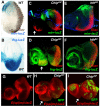The transcriptional co-factor Chip acts with LIM-homeodomain proteins to set the boundary of the eye field in Drosophila
- PMID: 20040493
- PMCID: PMC2799160
- DOI: 10.1242/dev.041244
The transcriptional co-factor Chip acts with LIM-homeodomain proteins to set the boundary of the eye field in Drosophila
Abstract
Development involves the establishment of boundaries between fields specified to differentiate into distinct tissues. The Drosophila larval eye-antennal imaginal disc must be subdivided into regions that differentiate into the adult eye, antenna and head cuticle. We have found that the transcriptional co-factor Chip is required for cells at the ventral eye-antennal disc border to take on a head cuticle fate; clones of Chip mutant cells in this region instead form outgrowths that differentiate into ectopic eye tissue. Chip acts independently of the transcription factor Homothorax, which was previously shown to promote head cuticle development in the same region. Chip and its vertebrate CLIM homologues have been shown to form complexes with LIM-homeodomain transcription factors, and the domain of Chip that mediates these interactions is required for its ability to suppress the eye fate. We show that two LIM-homeodomain proteins, Arrowhead and Lim1, are expressed in the region of the eye-antennal disc affected in Chip mutants, and that both require Chip for their ability to suppress photoreceptor differentiation when misexpressed in the eye field. Loss-of-function studies support the model that Arrowhead and Lim1 act redundantly, using Chip as a co-factor, to prevent retinal differentiation in regions of the eye disc destined to become ventral head tissue.
Figures







Similar articles
-
Ssdp proteins bind to LIM-interacting co-factors and regulate the activity of LIM-homeodomain protein complexes in vivo.Development. 2003 May;130(9):1915-25. doi: 10.1242/dev.00389. Development. 2003. PMID: 12642495
-
Chip is an essential cofactor for apterous in the regulation of axon guidance in Drosophila.Development. 2000 May;127(9):1823-31. doi: 10.1242/dev.127.9.1823. Development. 2000. PMID: 10751171
-
Chip-mediated partnerships of the homeodomain proteins Bar and Aristaless with the LIM-HOM proteins Apterous and Lim1 regulate distal leg development.Development. 2004 Jul;131(13):3107-20. doi: 10.1242/dev.01161. Epub 2004 Jun 2. Development. 2004. PMID: 15175252
-
[Drosophila genes that encode LIM-domain containing proteins: their organization, functions, and interactions].Tsitol Genet. 2006 Jul-Aug;40(4):44-67. Tsitol Genet. 2006. PMID: 17100280 Review. Russian.
-
Antennapedia: The complexity of a master developmental transcription factor.Genesis. 2024 Feb;62(1):e23561. doi: 10.1002/dvg.23561. Epub 2023 Oct 13. Genesis. 2024. PMID: 37830148 Review.
Cited by
-
Competition among gene regulatory networks imposes order within the eye-antennal disc of Drosophila.Development. 2013 Jan 1;140(1):205-15. doi: 10.1242/dev.085423. Development. 2013. PMID: 23222441 Free PMC article.
-
The H3K9 methyltransferase SETDB1 maintains female identity in Drosophila germ cells.Nat Commun. 2018 Oct 8;9(1):4155. doi: 10.1038/s41467-018-06697-x. Nat Commun. 2018. PMID: 30297796 Free PMC article.
-
A glimpse into dorso-ventral patterning of the Drosophila eye.Dev Dyn. 2012 Jan;241(1):69-84. doi: 10.1002/dvdy.22764. Epub 2011 Oct 27. Dev Dyn. 2012. PMID: 22034010 Free PMC article. Review.
-
Lmx1a is required for the development of the ovarian stem cell niche in Drosophila.Development. 2018 Apr 25;145(8):dev163394. doi: 10.1242/dev.163394. Development. 2018. PMID: 29615466 Free PMC article.
-
A Cyclin E Centered Genetic Network Contributes to Alcohol-Induced Variation in Drosophila Development.G3 (Bethesda). 2018 Jul 31;8(8):2643-2653. doi: 10.1534/g3.118.200260. G3 (Bethesda). 2018. PMID: 29871898 Free PMC article.
References
-
- Baker N. E. (1988). Transcription of the segment-polarity gene wingless in the imaginal discs of Drosophila, and the phenotype of a pupal-lethal wg mutation. Development 102, 489-497 - PubMed
-
- Baonza A., Freeman M. (2002). Control of Drosophila eye specification by Wingless signalling. Development 129, 5313-5322 - PubMed
-
- Blair S. S., Brower D. L., Thomas J. B., Zavortink M. (1994). The role of apterous in the control of dorsoventral compartmentalization and PS integrin gene expression in the developing wing of Drosophila. Development 120, 1805-1815 - PubMed
-
- Blanco J., Seimiya M., Pauli T., Reichert H., Gehring W. J. (2009). Wingless and Hedgehog signaling pathways regulate orthodenticle and eyes absent during ocelli development in Drosophila. Dev. Biol. 329, 104-115 - PubMed
Publication types
MeSH terms
Substances
Grants and funding
LinkOut - more resources
Full Text Sources
Molecular Biology Databases

